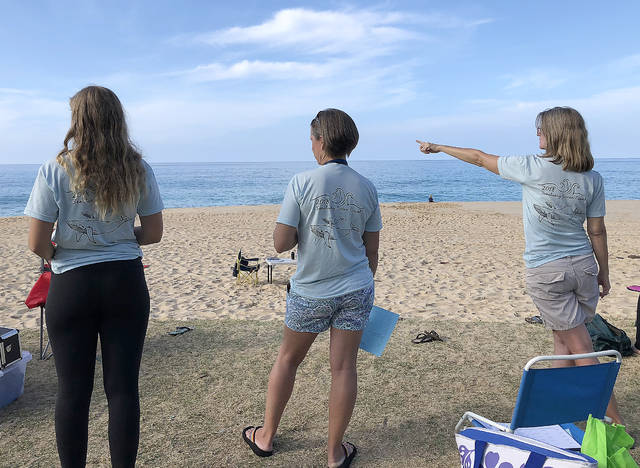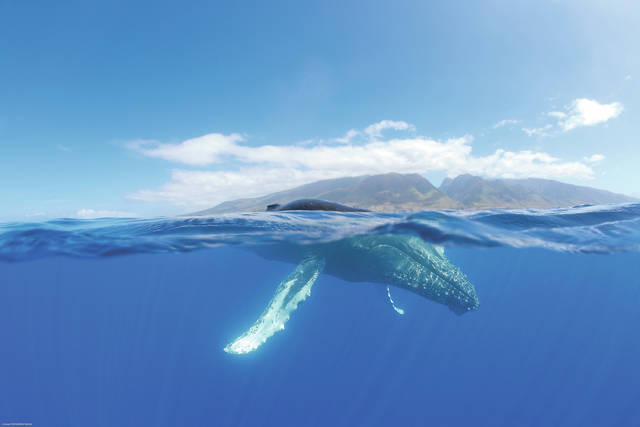KAILUA-KONA — The annual humpback whale ocean count will take place despite the federal government shutdown thanks to volunteers and the National Marine Sanctuary Foundation.
Ocean Count is a community citizen science project that occurs during the peak of whale season in the months of January to March to promote public awareness about humpback whales. Although removed from the endangered species list in 2016, most humpback whales remain a federally protected species.
It’s normally conducted by the Hawaiian Islands Humpback Whale National Marine Sanctuary, which strives to protect humpback whales and their habitat in Hawaii. However, this year, the National Marine Sanctuary Foundation, which is the nonprofit partner of the National Marine Sanctuary System, will coordinate the count because of the shutdown.
“Through the support of dedicated volunteers, Ocean Count has provided more than 20 years of data that supplements scientific research and helps monitor humpback whales during their annual migration to the Hawaiian Islands,” said Kris Sarri, the foundation’s president and CEO.
“Fewer humpback whales are being observed in the main Hawaiian Islands in recent years, and we don’t know why,” she added. “Unfortunately, critical sanctuary research that could help us understand these changes is on hold indefinitely due to the government shutdown.”
Over 300 volunteers are expected to participate in the foundation-coordinated whale count on Jan. 26 statewide. Volunteers are responsible for tallying the amount of humpback whales they see from shore, and documenting their surface behavior.
Other counts are scheduled for Feb. 23 and March 30 throughout the state. All counts take place from 8 a.m. to 12:15 p.m.
“It’s a way to spread the word about what’s happening with whales in our area,” said George Winchell, who is the site leader at the Four Seasons Resort Hualalai Ocean Count site and has been a volunteer for almost 15 years. “Most of the people who come are visitors, so it’s a good way to introduce them to our whale population.”
Each year, approximately 11,000 humpback whales migrate from Alaska to Hawaii where they mate and give birth during the winter. However, within the past four years, that number has greatly declined, with an estimated 50-80 percent drop in humpback whale sightings.
Ongoing speculation and many theories have developed about the sudden decline in the whale populations presence in Hawaii. In November, a group of whale experts met in Honolulu to better understand the sudden decrease of these marine mammals, and find a solution for it.
Information presented showed a correlation between warmer ocean temperatures and missing whales.
It was discovered that three factors have attributed to the unusually heated waters in the Alaska region since 2014 — the same year scientists noticed a drop in whale sightings in the islands. These are: a change in the ocean current — called the Pacific Decadal Oscillation, a large “blob” of warm water, and a warm El Nino period in 2016.
The sudden temperature change could cause the whales to move or spread out to cooler northern waters as a way to find prey and food such as krill. Although scientists agree that the decline of whale sightings in Alaska and Hawaii is due to their change or search for food, it is still unknown whether there is a larger issue impacting the habitat.
In the last three years, Winchell’s noticed firsthand that there has been a definite decrease in whale sightings specifically at the Four Seasons Resort Hualalai.
“That doesn’t mean that there’s less whales, but it does mean that there are less whales within our observation area,” he said.
There are 21 whale count locations on the Big Island.
Anyone interested in volunteering can register in advance at www.oceancount.org. More information can also be obtained by emailing oceancount@marinesanctuary.org.










As reported in numerous news outlets in the last 48 hours – this latest scientific study reveals the world’s oceans are warming faster than previously estimated. Test measurements of ocean waters down to 2,000 meters (6,600 ft), are setting a new temperature records in 2018 in a trend that is damaging to all marine life.
Man-made (fossil fuel) greenhouse gas emissions are warming the atmosphere, and a large part of the heat gets absorbed by the oceans. That in turn is forcing the food supply for whales to flee to cooler waters, far north of Hawai’i. The loss of whales in Hawaii’s waters is only one many global warming impacts now being felt locally.
The National Academy of Sciences reports that upwards of 90 percent of the heat trapped by greenhouse gas emissions has been absorbed by the oceans, while only a few percent have impacted the air, land, and ice caps.
So your best guess is 10 maybe 20 years at best before we are all toast. will Ali’i drive be under water too? You sound like you know what your talking about. Should we defend Hawaii, like the bumper sticker say? Please give us direction.
To KonaRich’s question, “So your best guess is 10 maybe 20 years at best before we are all toast. will Ali’i drive be under water too? … “Please give us direction.”
Everyone alive today is experiencing the initial stages of a carbon emissions feedback loop we humans began to set in motion 150 years ago with industrialization (the widespread burning of fossil fuels) and combined with accelerated of global population growth with its compounding effects – in short, global warming is a train that has already left the station. The best we can do at this point to prepare and mitigate as possible the warming impacts now underway.
Hawai’i is in a unique position to prepare itself for the changes already happening. Energy and food independence are well established must do’s for our island state and should be immediate (not future) priorities – how we get there from here is the primary challenge for the state and for individual residents. As for Ali’i Drive, yes it will be flooded more often than not in the coming the decades – my guess, likely 15 to 30 years.
In addition, Big Island Kona and Hilo airports will be impacted by sea level rise, along with our island ports. Since we are totally dependent on a continuous and tenuous supply-chain, any infrastructure disruptions will have major impacts both locally and in Oahu, the state’s hub and spoke dependent distribution system.
Based on climate change impacts on the jet stream and corresponding weather patterns along with the generation of now normal super storm events, there is no place to hide (including the mainland) from global climate consequences now underway. Hawai’i however, if properly prepared, can weather the changes now underway better than most places.
Computer models, based on the most recent data indicate (no guarantees) that Hawaii’s mid-Pacific location may mitigate some of the effects from temperature rise. Unfortunately, impacts to the island chains fishery is already happening, ranging from coral bleaching to dwindling fish stocks – the latter, a global trend.
As for “defending Hawaii”, we need to begin with a fully self-sufficient and clean-energy based economy. Prioritize homegrown agricultural at a commercial scale as much as possible (supplementing with home gardens), and stock pile food reserves for the items we cannot producer locally to smooth out supply-chain disruptions.
Accelerate the electrification of ground and water-based transportation, personal and commercial (options continue to grow), and ensure that all forward planning for utility scale energy power plants will be solar, wind, storage (battery and water systems), and geothermal – in other words locally produced, emission-free, and sustainable. The list goes on …
It’s not all doom and gloom, global warming is also the must-do opportunity for Hawai’i to advance itself beyond a dependency on imported tourism as its sole economic driver, which so far has been an unsustainable path for the state’s future.
I spent a lifetime as an employee of a Tier 1 supplier to the auto
industry and it was filled with both temporary and indefinite layoffs.
Never once did the MSM consider our job losses worth reporting on.
So what makes these government employees, who are likely experiencing
the first layoffs in their lives, so important and more relevant than
the people in the private sector? If the MSM wants an end to these
temporary layoffs, then demand PELOSI AND SCHUMER APPROVE THE SPENDING
FOR THE WALL!!!!!
Try not to be an idiot, if you can.